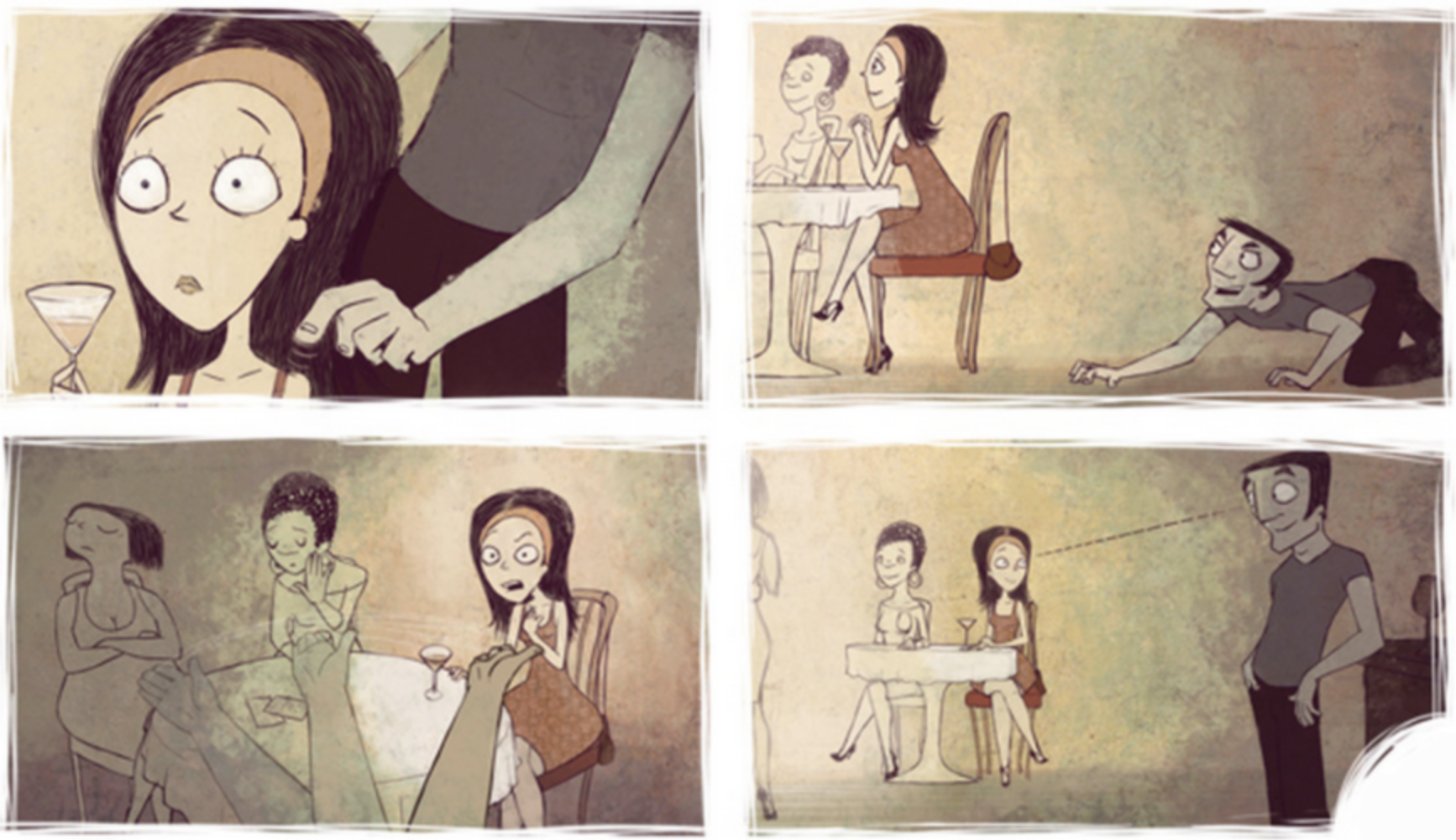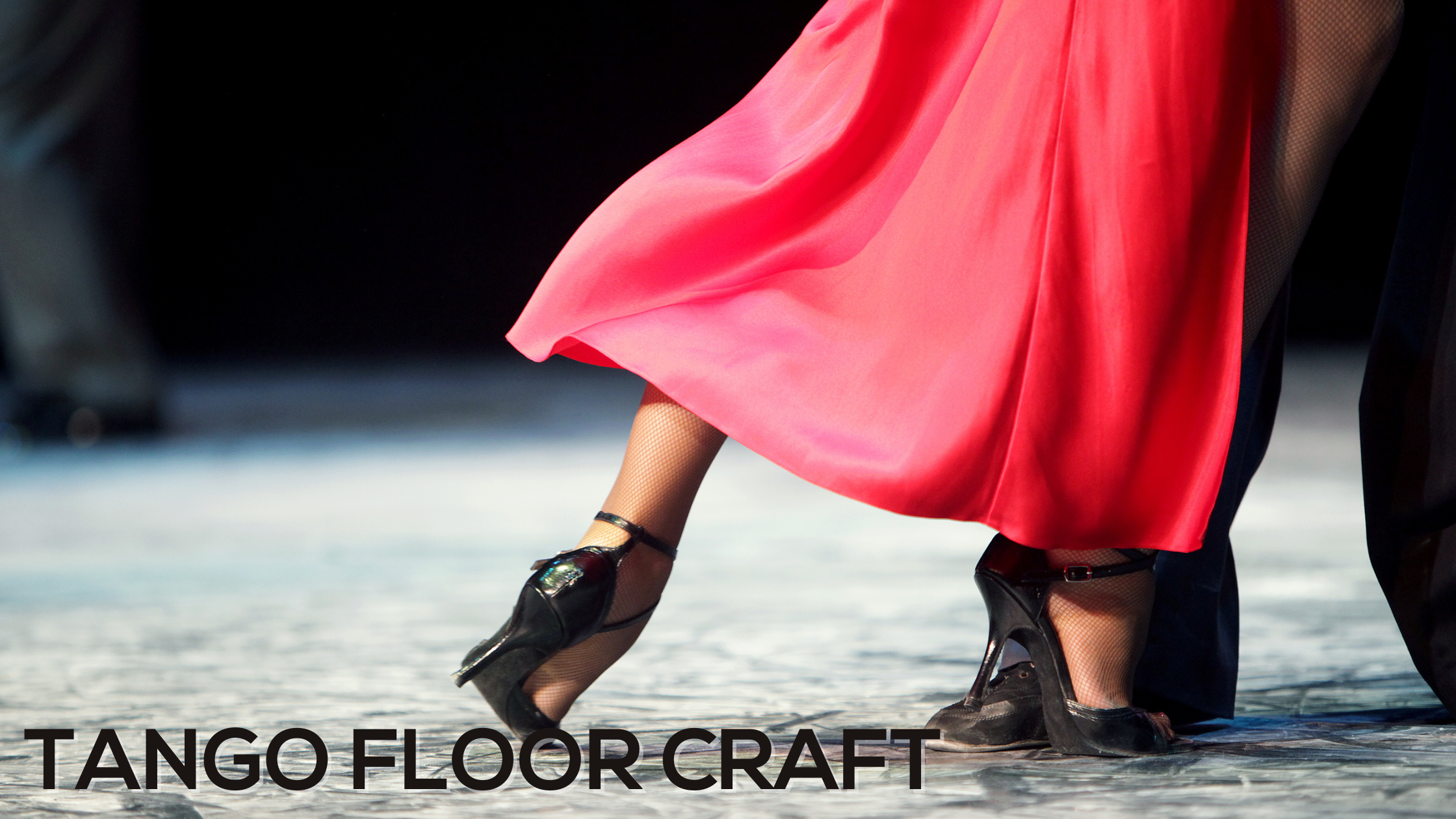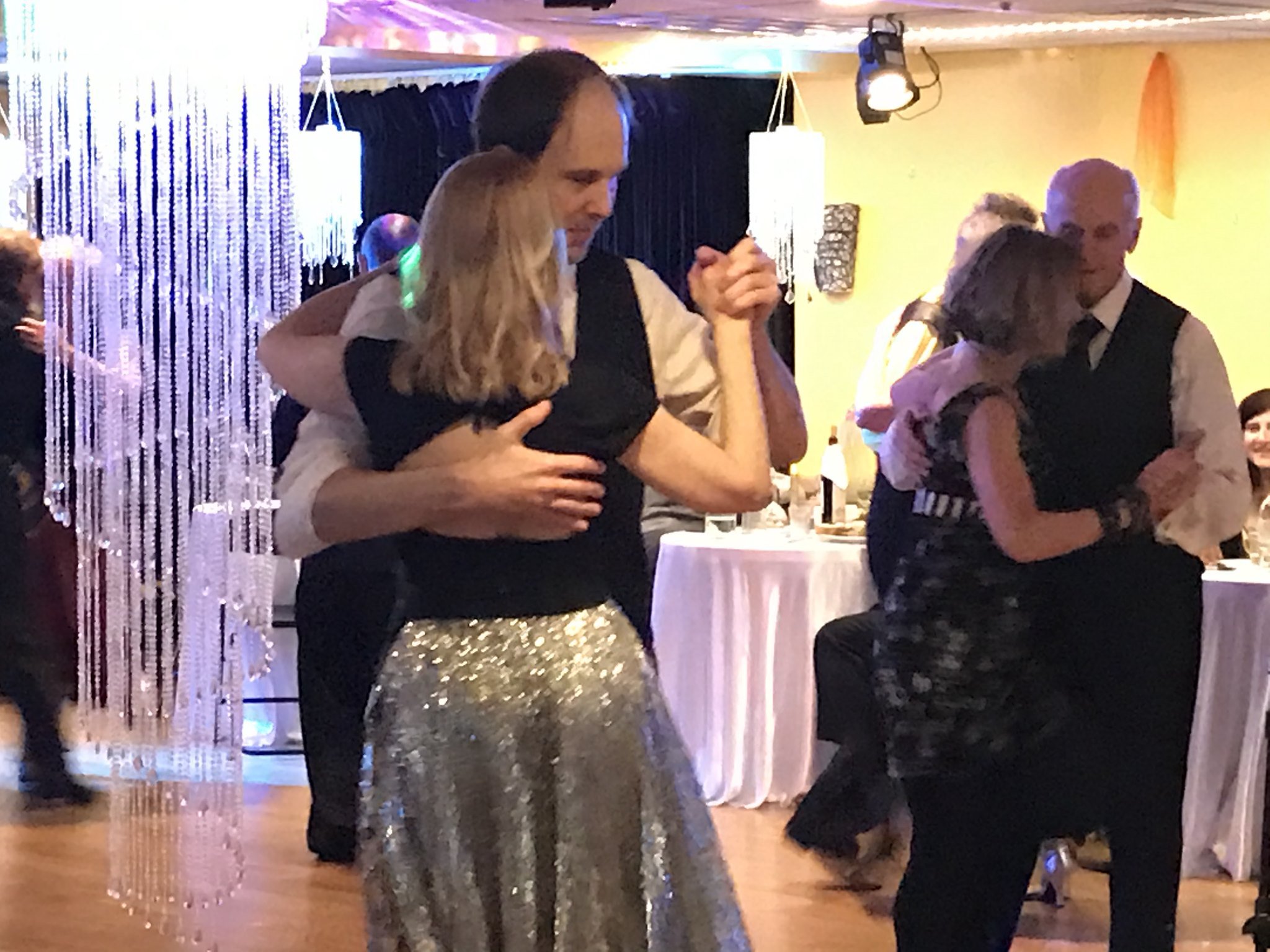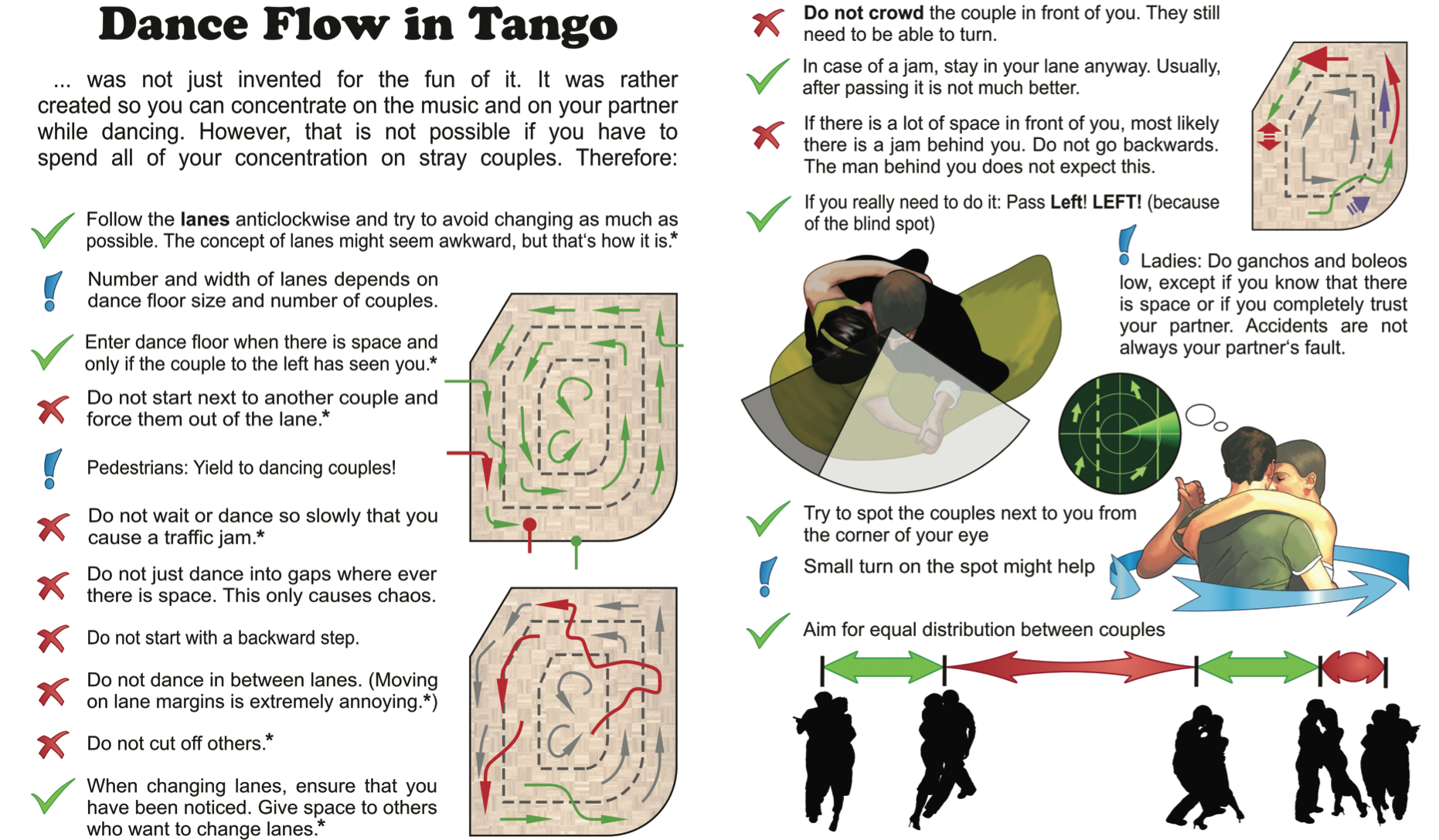Navigation: The Ultimate Tango Skill
Let's say a tanguero and a tanguera are on a packed dance floor, executing the steps so flawlessly that they look stellar and breathtaking.
However, as they move around the floor, they hit other couples as they maintain their connection and keep time with the music. Would they still be considered good dancers?
The answer is no.
We are happy to announce that we located the author of the above illustration!!!!! One and only Anya Weiss!!!!
In tango, floor craft — the ability to navigate around the floor without bumping into other couples — is just as important as the dance steps.
A dancer can be technically very skillful, but their dancing will be severely limited without navigation. To make things worse, they also limit other dancers on the dance floor.
Good dancers commit to mastering navigation as much as they do to the steps. After all, floor craft is what allows a dancer to really show off their skills and creativity on the dance floor.
Remember: tango is not just about the steps — it's about the connection, the music, and the floor.
What Is Tango Floor Craft?
Floor craft is the ability to move around the floor in a way that is both efficient and elegant.
As Dirk Apitz stated in his 2012 graphic about dance flow in tango, it wasn't invented just for fun. Instead, floor craft is a necessity in tango because of the way the dance is danced.
The first thing to understand about floor craft is that it is not just about avoiding collisions. In fact, if you focus only on that, you will likely end up sacrificing musicality and connection with your partner.
Instead, floor craft is about finding the most efficient and elegant way to move around the floor while still being able to dance the tango.
As they learn about navigation in tango, dancers will come across terms like the line of dance (LOD) and the tango codes or códigos. These can be challenging to wrap your head around at first, but once you understand them, they will be invaluable in helping you navigate the floor. As a result, all the dancers on the dance floor will have a much better time.
Tango Codes
Before diving deep into navigation in tango, it's vital to refresh your memory on the códigos of tango.
These are unspoken rules that all dancers should adhere to while dancing. The codes help to maintain order on the dance floor and to keep dancers safe.
Yes, navigation is a significant part of the codes.
How does a dancer invite another dancer to dance at a milonga or a tango party?
According to Siempre Milonguero, this invitation is the cabeceo. A leader or a follower can use eye contact to invite the other person to dance.
This is considered much more polite than simply tapping someone on the shoulder. Once the eye contact is established, a simple nod of the head is all that's needed to confirm that you would like to dance.
What if someone doesn't want to dance? They can say no by just looking away.
This is more considerate of the feelings of both the person who asked and the person who said no. There is no need for any words to be exchanged.
When two dancers do want to dance, the dancer who initiated the invite shall walk toward the follower without breaking eye contact. Whenever they are ready, they can head over to the dance floor and begin.
Leaders are generally responsible for opening up the dance floor and finding a spot for their couple.
An important rule to keep in mind is that couples cannot just enter and leave the dance floor whenever they want. They should always inform the dancers before them of their intention to enter or exit the floor.
Do they have to announce it out loud? No. The leader must still use eye contact to indicate their intention. This way, all couples can maintain their connection to their partners, the music, and the floor without causing any disruptions.
Once a dancer accepts another dancer's invitation, they must dance with that person until the end of a tanda.
However, dancers are not allowed to teach or learn about tango in milongas. That's what practicas are for.
Practicas are tango classes that are usually held before or after milongas.
They provide a space for dancers to focus on learning and practicing without disrupting the flow of the milonga.
These are a lot to remember as a dancer in a milonga. For beginners, it can be very overwhelming, but don't worry; the codes will become easier with time and practice. Eventually, they become second nature! Of course, the skill doesn't stop there.
A tango dancer can master all these codes, but once they set foot on the floor, they're nothing without floor craft.
Mastering the Navigation
Tanguito compared navigation in tango to driving.
If tango required a license to dance, would you be able to pass the test? Tanguito gave a driving set-up and four situations. Actually, you shall read the whole article, as it is hilarious!
“You're driving on the M25, thinking about the weekend. The driver ahead of you drives a red Vauxhall slightly below the speed limit. The driver in the blue Ford in the next lane stays slightly behind you at a constant speed.
The driver in the red Vauxhall MAKES A SUDDEN U-TURN and faces you – hood against the hood. You somehow manage to brake and stop about 2 yards from him. You’re sweating and swearing. In your heart, you are happy you have wasted your youth on a racing video game (but will never ever tell your son): you still have damn good reflexes.
You are about to start insulting him when you realize there’s no time for that. HE IS STARTING TO DRIVE TOWARDS YOU!!!! As far as you can tell, he is looking at his feet and not at the road ahead. Maybe he lost his contact lenses and can’t tell he is going in the wrong direction.
What do you do?”
What if the red Vauxhall cannot decide if they want to speed up or slow down? Maybe they start to zigzag between lanes? What if they transform into a war weapon from hell?
Well, the last situation doesn't literally happen in social tango, but if you ever find yourself on the dance floor, and another couple suddenly crashes into you, you'll need to know what to do.
The Line of Dance
Start by getting to know the LOD. According to Mariano Diaz Campos from Tango Master Class,
the LOD (line of dance) — or the La Ronda — is an imaginary line that circles the floor counter-clockwise.
It's like the “inside lane” on a highway.
You can only travel in one direction on the LOD which is essential because it prevents collisions, allowing couples to dance smoothly without running into each other.
The LOD is not a straight line. It has curves and turns. The turns are usually around the corner of the floor, so it's important to know where they are. You don't want to be caught off-guard and find yourself dancing into a wall and disrupting the couples following you.
When in the La Ronda, remember these ten principles listed by the Madison Tango Society:
Maintain a lane.
Look before backing up.
Avoid passing.
No parking.
Never zigzag.
Don't monopolize the space.
Avoid dangerous moves.
Don't talk; dance!
Dance with the room.
Ask before merging.
Tango navigation really is just like driving.
You have to be aware of your surroundings and be able to anticipate what the other couples around you are going to do. You also have to know the floor and where the turns are.
All dancers are responsible for ensuring the floor is a safe and enjoyable place for everyone.
As Tanguito also said:
“Tango dancers walking against the line of dance… or charging on the dancefloor and then stopping abruptly… High flying boleos, wraps and ganchos… Scary thought!”
Dancers have to commit to one lane, allow enough space for others, and keep the same distance with the couple ahead of them.
Overtaking is a big mistake, so dance in a straight line and mark corners with a 90-degree turn. These are all pure tango bliss!
How is it possible to still enjoy the dance and maintain the connection between you and your partner, the music, and the floor?
Navigation is called the ultimate tango skill because it is the one skill that ties all the others together.
It allows you to move gracefully around the floor, respect the other couples, and respect the dance floor. When you can navigate well, you can really let go and enjoy the dance.
When Learning About Navigation
Should tango dancers learn about the dance first or the navigation?
There are different schools of thought on this, but it is important to learn both at the same time. Navigation is an integral part of the dance, and you can't really separate the two. As Mariano Diaz Campos said:
“With an elegant balance and a caminada the navigation can be practiced really well from the very beginning.
The caminada helps to dance in the ronda, and the balance is great to use to dance on the spot. Next is the cunita, a simple turn on the spot. This is useful for the leaders to learn to scan the dancers around them, and get a sense of the flow on the dance floor.”
Navigating the LOD is crucial to being a good tango dancer.
This can be easily proven in milongas, where professional dancers constantly move around the floor, avoiding other couples and not disrupting the dance flow.
Tango is impossible to appreciate if you're not allowing everyone to do it.
Of course, some moves are more challenging to navigate than others. Still, with practice, you should be able to do them all while maintaining the connection with your partner and the floor. Navigation is still about the connection between the dancers, the music, and the floor. Learning the tango is nothing without learning how to navigate it.
Navigation is still about the connection between the dancers, the music, and the floor. Learning the tango is nothing without learning how to navigate it.
Navigating the World of Tango
Tango is undoubtedly a beautiful social dance.
It's a way to connect with people, history, and culture and share a common experience. However, it's also a lot more than that.
Tango is a way to navigate the dance floor that holds all the dancers. It's a way to move through the world and connect with others who are doing the same.
Floor craft is indeed a significant aspect of tango — it’s one of the things that makes a good dancer. A good tanguero or tanguera is someone who can navigate the floor, the music, and their partner with ease. They’re someone who knows how to lead, follow, and respect the floor and the other couples who want to let tango live in them.
Learning Tango shared a conversation in ‘Negracha’:
“‘How many times have you been stepped on or kicked by other dancers tonight?’
‘Maybe a dozen.’
‘Doesn't that bother you?’
‘You just accept it as the price you pay for dancing.’”
This is somewhat true. Dancers accept it as the price they pay for dancing. Who doesn't love tango? Who can resist the boleos, soltadas, and the back sacadas? Who can resist the feeling of being in somebody's arms, moving to the music, and forgetting about the world? Tangueros and tangueras can't!
To truly love tango is to be able to navigate it. It's the only way to move through the world of tango and feel its true meaning.
When you're learning to dance, make sure you're also learning how to navigate the floor. It can be mind-boggling at first, restricting you to a single spot on the floor or scaring you with its intimidating rules.
With time, you'll see that it's all worth it. Learning to navigate is learning the ultimate tango skill.












